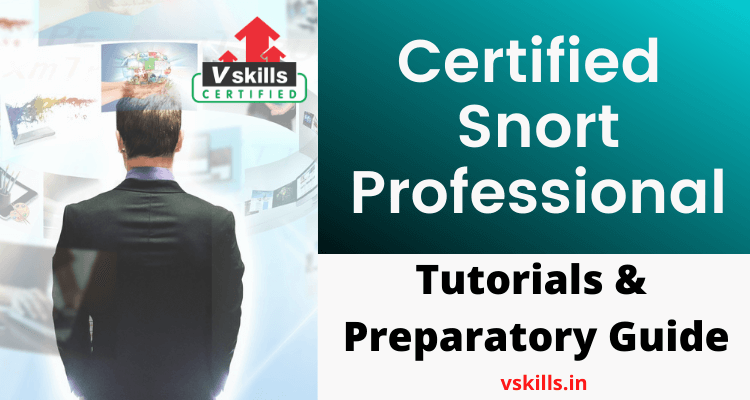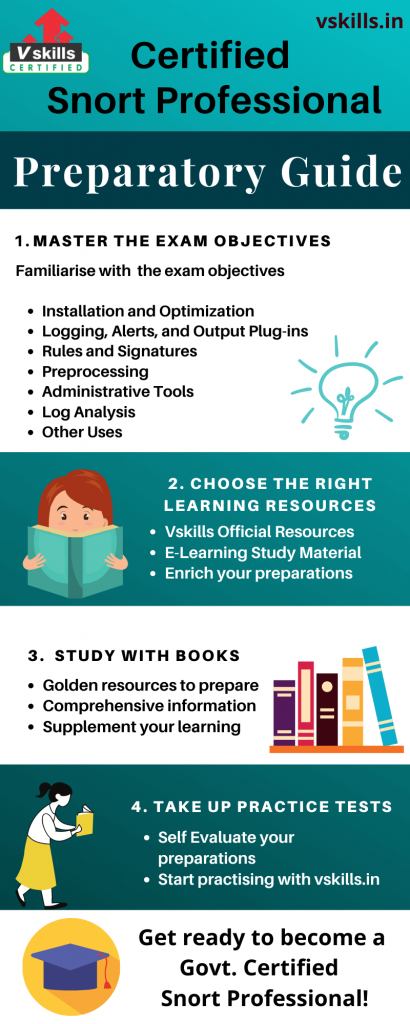
Certification can open the door to increased visibility, better opportunities and new jobs in your industry. In today’s highly competitive environment, certification differentiates you as a professional who is serious about applied learning, making you an asset to a prospective employer. A Certified Snort Professional validates their skills and expertise to advance in their chosen field.
Roles and Responsibilities
A Certified Snort Professional is responsible for to monitoring traffic, log packets and analysing protocols. They play a significant role in an organisation. They must find the methods to protect their data and network system to reduce the risk from attacks. Moreover, Snort is an open source network intrusion detection system and a certified professional that monitors network traffic in real time, scrutinizing each packet closely to detect a dangerous payload or suspicious anomalies.
Vskills Certified Snort Professional
Vskills certification for Snort Professional assesses the candidate as per the company’s need for network security and assessment. The certification tests the candidates on various areas in installing and running Snort, building IDS, Plug-ins, logging, alerts, log analysis, rules, signatures, preprocessing Snortsnarf and other usage of Snort.
Why become a Vskills Certified Snort Professional?
Earning Vskills Snort Professional Certification can help candidate differentiate in today’s competitive job market, broaden their employment opportunities by displaying their advanced skills, and result in higher earning potential. Professionals who want to improve their skill set to make their CV stronger and existing employees looking for a better role can prove their employers the value of their skills through this certification. Moreover Vskills certification guarantee the following benefits:
- The certifications will have a Government verification tag.
- The Certification is valid for life.
- Lifelong e-learning access.
- Access to Free Practice Tests.
- You will get tagged as ‘Vskills Certified’ On Monsterindia.com and ‘Vskills Certified’ On Shine.com.
Target Audience
This certification is intended for Job seekers looking to find employment in networking, security or IT departments of various companies. It is also well suited for those who are already working and would like to take certification for further career progression. Companies specializing in network security or network management are constantly hiring skilled Snort Professionals. Various public and private companies also need Snort Professionals for their networking, security or IT departments.
Exam Details: Certified Snort Professional
- Exam Code: VS-1148
- Duration: 60 minutes
- No. of questions: 50
- Maximum marks: 50
- Passing marks: 25 (50%).
- There is NO negative marking
- This is an Online exam
Exam Process

Course Outline: Certified Snort Professional
This exam covers the following topics:
1. Installation and Optimization
- 1.1 Introduction
- 1.2 Installing Snort from Source
- 1.3 Installing Snort
- 1.4 Upgrading Snort
- 1.5 Monitoring Multiple Network Interfaces
- 1.6 Invisibly Tapping a Hub
- 1.7 Invisibly Sniffing Between Two Network Points
- 1.8 Invisibly Sniffing MB Ethernet
- 1.9 Sniffing Gigabit Ethernet
- 1.10 Tapping a Wireless Network
- 1.11 Positioning Your IDS Sensors
- 1.12 Capturing and Viewing Packets
- 1.13 Logging Packets That Snort Captures
- 1.14 Running Snort to Detect Intrusions
- 1.15 Reading a Saved Capture File
- 1.16 Running Snort as a Linux Daemon
- 1.17 Running Snort as a Windows Service
- 1.18 Capturing Without Putting the Interface into Promiscuous Mode
- 1.19 Reloading Snort Settings
- 1.20 Debugging Snort Rules
- 1.21 Building a Distributed IDS
2. Logging, Alerts, and Output Plug-ins
- 2.1 Introduction
- 2.2 Logging to a File Quickly
- 2.3 Logging Only Alerts
- 2.4 Logging to a CSV File
- 2.5 Logging to a Specific File
- 2.6 Logging to Multiple Locations
- 2.7 Logging in Binary
- 2.8 Viewing Traffic While Logging
- 2.9 Logging Application Data
- 2.10 Logging to the Windows Event Viewer
- 2.11 Logging Alerts to a Database
- 2.12 Installing and Configuring MySQL
- 2.13 Configuring MySQL for Snort
- 2.14 Using PostgreSQL with Snort and ACID
- 2.15 Logging in PCAP Format (TCPDump)
- 2.16 Logging to Email
- 2.17 Logging to a Pager or Cell Phone
- 2.18 Optimizing Logging
- 2.19 Reading Unified Logged Data
- 2.20 Generating Real-Time Alerts
- 2.21 Ignoring Some Alerts
- 2.22 Logging to System Logfiles
- 2.23 Fast Logging
- 2.24 Logging to a Unix Socket
- 2.25 Not Logging
- 2.26 Prioritizing Alerts
- 2.27 Capturing Traffic from a Specific TCP Session
- 2.28 Killing a Specific Session
3. Rules and Signatures
- 3.1 Introduction
- 3.2 How to Build Rules
- 3.3 Keeping the Rules Up to Date
- 3.4 Basic Rules You Shouldn’t Leave Home Without
- 3.5 Dynamic Rules
- 3.6 Detecting Binary Content
- 3.7 Detecting Malware
- 3.8 Detecting Viruses
- 3.9 Detecting IM
- 3.10 Detecting PP
- 3.11 Detecting IDS Evasion
- 3.12 Countermeasures from Rules
- 3.13 Testing Rules
- 3.14 Optimizing Rules
- 3.15 Blocking Attacks in Real Time
- 3.16 Suppressing Rules
- 3.17 Thresholding Alerts
- 3.18 Excluding from Logging
- 3.19 Carrying Out Statistical Analysis
4. Preprocessing: An Introduction
- 4.1 Introduction
- 4.2 Detecting Stateless Attacks and Stream Reassembly
- 4.3 Detecting Fragmentation Attacks and Fragment Reassembly with Frag
- 4.4 Detecting and Normalizing HTTP Traffic
- 4.5 Decoding Application Traffic
- 4.6 Detecting Port Scans and Talkative Hosts
- 4.7 Getting Performance Metrics
- 4.8 Experimental Preprocessors
- 4.9 Writing Your Own Preprocessor
5. Administrative Tools
- 5.1 Introduction
- 5.2 Managing Snort Sensors
- 5.3 Installing and Configuring IDScenter
- 5.4 Installing and Configuring SnortCenter
- 5.5 Installing and Configuring Snortsnarf
- 5.6 Running Snortsnarf Automatically
- 5.7 Installing and Configuring ACID
- 5.8 Securing ACID
- 5.9 Installing and Configuring Swatch
- 5.10 Installing and Configuring Barnyard
- 5.11 Administering Snort with IDS Policy Manager
- 5.12 Integrating Snort with Webmin
- 5.13 Administering Snort with HenWen
- 5.14 Newbies Playing with Snort Using EagleX
6. Log Analysis
- 6.1 Introduction
- 6.2 Generating Statistical Output from Snort Logs
- 6.3 Generating Statistical Output from Snort Databases
- 6.4 Performing Real-Time Data Analysis
- 6.5 Generating Text-Based Log Analysis
- 6.6 Creating HTML Log Analysis Output
- 6.7 Tools for Testing Signatures
- 6.8 Analyzing and Graphing Logs
- 6.9 Analyzing Sniffed (Pcap) Traffic
- 6.10 Writing Output Plug-ins
7. Other Uses
- 7.1 Introduction
- 7.2 Monitoring Network Performance
- 7.3 Logging Application Traffic
- 7.4 Recognizing HTTP Traffic on Unusual Ports
- 7.5 Creating a Reactive IDS
- 7.6 Monitoring a Network Using Policy-Based IDS
- 7.7 Port Knocking
- 7.8 Obfuscating IP Addresses
- 7.9 Passive OS Fingerprinting
- 7.10 Working with Honeypots and Honeynets
- 7.11 Performing Forensics Using Snort
- 7.12 Snort and Investigations
- 7.13 Snort as Legal Evidence in the U.S.
- 7.14 Snort as Evidence in the U.K.
- 7.15 Snort as a Virus Detection Tool
- 7.16 Staying Legal
Preparatory Guide: Certified Snort Professional
Preparing for an exam is quite a difficult task. It becomes easier when you follow a preparatory guide. Here we provide you with our guide to smoothen your journey for this exam

Step 1- Master the Exam Objectives
Now that you’ve reviewed the exam details regarding the exam. It’s time to make sure that you are up to date with the Course Outline. The Course Outline is the most crucial part of the examination as it covers the exam objectives. These objectives act as a blueprint for the exam. You should be very clear with the syllabus and devote enough time to each and every exam concept and have in depth knowledge of the subject. This exam covers the following objectives:
- Installation and Optimization
- Logging, Alerts, and Output Plug-ins
- Rules and Signatures
- Preprocessing
- Administrative Tools
- Log Analysis
Other Uses
Step 3- Choose the Right Learning Resources
finding the right learning resources will allow you to understand each and every concept covered in this exam. You should choose the right resources as they determine your preparation level. Moreover these resources should be from authentic and genuine sources. Vskills offers its own official resources to help you prepare for this exam. The E-Learning and Study Material by Vskills is offered with lifetime access. Additionally, these resources are constantly updated to provide you with latest information.
Refer: Certified Snort Professional Sample Chapter
Step 2- Study the Traditional way through books



Preparation for any exam without books seems unreasonable and unproductive at the same time. You should refer the right books to gain in depth knowledge about the exam. Moreover, select relevant and credible books by expert authors for your exam preparations. Most important of all, you can find real-time examples of the different concepts you learn for the certification exam. As a result, you can strengthen your knowledge and boost your preparations. You must refer the following books while preparing for this exam:
- Firstly, Snort 2.1 Intrusion Detection, Second Edition
- Secondly, Managing Security with Snort and IDS Tools
- Also, Intrusion Detection With SNORT, Apache, MySQL, PHP, And ACID
- Additionally, Snort Cookbook
Step 4- Practice Practice and Practice
Finally, we’re on the last step for the preparatory guide. Further, this final step will give the candidate the exact insight of the topics in which they’re lacking. So, make sure you’re going through practice tests after you have gone through the entire syllabus. Likewise, all the practice tests are designed to encounter the real exam environment around you. Practice papers give that simulation in which the brain needs to get used to the actual exam. Other than knowledge, there are many factors that can affect your performance in the exam. Also, these include confidence, speed, understanding the marking scheme, physical and mental alertness and concentration, and more. Moreover, attempting multiple practice tests will boost your confidence. Try outperforming yourself with each subsequent test. Start practising with free Practice Tests Now!


